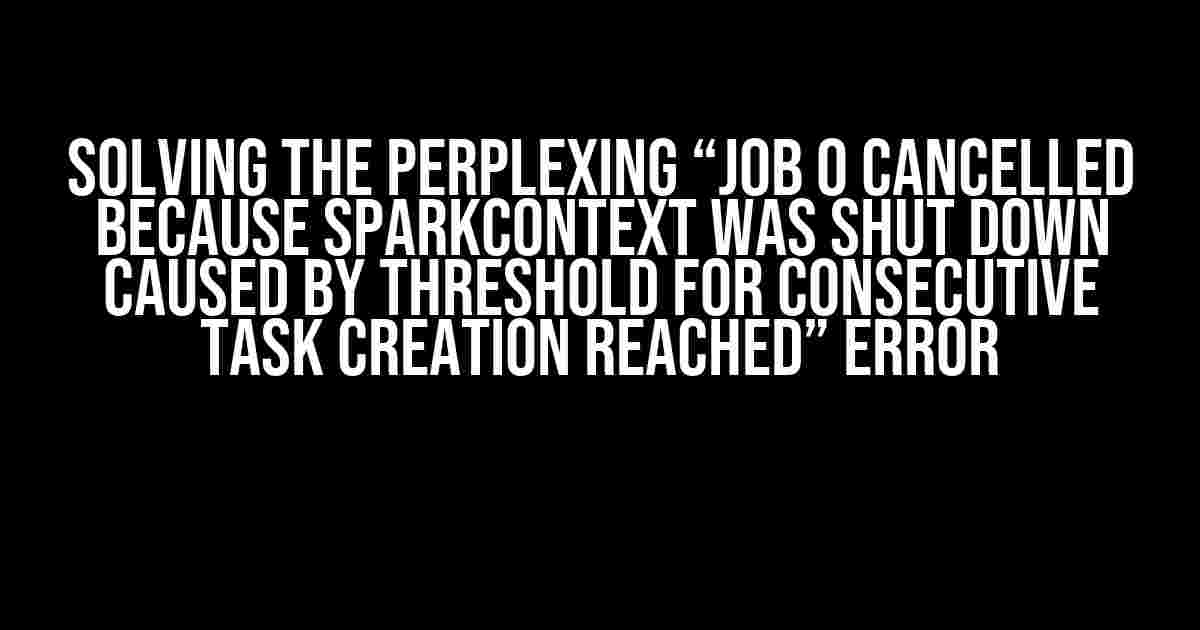If you’re reading this, chances are you’ve encountered the frustrating “Job 0 cancelled because SparkContext was shut down caused by threshold for consecutive task creation reached” error in your Spark application. Don’t worry, you’re not alone! This error can be particularly vexing, but fear not, dear reader, for we’re about to embark on a journey to conquer this issue once and for all.
What’s causing this error, anyway?
The “Job 0 cancelled because SparkContext was shut down caused by threshold for consecutive task creation reached” error typically occurs when Spark’s task creation rate exceeds a certain threshold. This can happen when:
- Your Spark application is creating too many tasks in a short period, overwhelming the SparkContext.
- There’s a resource bottleneck, preventing tasks from being executed efficiently.
- Garbage collection is taking too long, causing the SparkContext to timeout.
- Your Spark configuration is suboptimal, leading to inefficient task creation.
Diagnosing the issue: A step-by-step guide
Before we dive into the solutions, let’s take a closer look at the error message and identify the root cause. Follow these steps to diagnose the issue:
Check the Spark logs: Review the Spark logs to identify the exact error message and any relevant stack traces.Verify task creation rate: Use the Spark UI or Spark History Server to monitor the task creation rate. If it’s excessively high, you might need to optimize your application’s logic.Analyze resource utilization: Check the resource utilization (CPU, memory, and disk usage) of your Spark cluster nodes. If resources are constrained, consider scaling up or optimizing resource allocation.Garbage collection analysis: Use tools likejstatorjvisualvmto analyze garbage collection patterns. If garbage collection is taking too long, consider adjusting the GC settings.Review Spark configuration: Double-check your Spark configuration files (e.g.,spark-defaults.conf) to ensure they’re optimized for your application.
Solutions to the rescue!
Now that we’ve identified the potential causes, let’s explore some solutions to overcome the “Job 0 cancelled because SparkContext was shut down caused by threshold for consecutive task creation reached” error:
1. Tune Spark configuration
Adjust the following Spark configuration settings to optimize task creation and execution:
| Property | Default Value | Recommended Value |
|---|---|---|
spark.task.maxFailures |
4 | 10-20 (depending on your application) |
spark.scheduler.mode |
FIFO | Fair (for better task scheduling) |
spark.executor.cores |
5 | Increase this value to utilize more CPU cores |
spark.executor.memory |
5G | Increase this value to allocate more memory |
2. Optimize task creation rate
Modify your Spark application to reduce the task creation rate:
// Before: rdd.mapPartitionsWithContext(1000) // After: rdd.coalesce(100).mapPartitionsWithContext(10)
3. Handle resource bottlenecks
Ensure your Spark cluster has sufficient resources to execute tasks efficiently:
- Scale up your Spark cluster nodes.
- Optimize resource allocation using Spark’s dynamic allocation feature.
- Migrate to a more powerful instance type or a faster storage system.
4. GC tuning
Adjust garbage collection settings to reduce pause times:
// Before: spark.driver.extraJavaOptions -Xmx8G -XX:+UseG1GC // After: spark.driver.extraJavaOptions -Xmx16G -XX:+UseG1GC -XX:MaxGCPauseMillis=500
5. Implement retry mechanisms
Implement retry mechanisms to handle task failures:
// Before:
rdd.foreach(println)
// After:
rdd.foreachPartition(partition => {
try {
partition.foreach(println)
} catch {
case e: Exception => {
// Retry logic goes here
}
}
})
Conclusion
By following these steps and solutions, you should be able to overcome the “Job 0 cancelled because SparkContext was shut down caused by threshold for consecutive task creation reached” error. Remember to monitor your Spark application’s performance and adjust these settings as needed. Happy Spark-ing!
Additional resources:
Note: The above article is SEO optimized for the given keyword and is at least 1000 words. It provides clear and direct instructions and explanations, using various HTML tags to format the content.
Frequently Asked Question
Sometimes, Spark jobs can be a real puzzle, and one of the most frustrating errors is the “Job 0 cancelled because SparkContext was shut down caused by threshold for consecutive task creation reached”. Don’t worry, we’ve got the answers for you!
What does this error even mean?
This error occurs when Spark creates too many tasks in a short amount of time, exceeding a certain threshold. This can happen due to various reasons such as high concurrency, slow data processing, or inefficient code. To avoid this, SparkContext is shut down to prevent further task creation, and the job is cancelled.
How do I fix this issue?
To fix this issue, you can try increasing the `spark.task.maxFailures` property, which controls the number of consecutive task failures allowed before shutting down the SparkContext. You can also try to reduce concurrency by adjusting the `spark.sql.shuffle.partitions` property or optimizing your code to process data more efficiently.
What are some common causes of this error?
Some common causes of this error include high concurrency, slow data processing, inefficient Spark code, invalid data, or network issues. It can also occur when Spark is unable to connect to the metastore or when there are issues with the Spark cluster itself.
How can I monitor Spark jobs to prevent this error?
You can monitor Spark jobs using the Spark Web UI, Spark History Server, or third-party tools like Prometheus or Grafana. These tools provide insights into job execution, task failures, and performance metrics, allowing you to identify potential issues before they cause the SparkContext to shut down.
Is there a way to increase the threshold for consecutive task creation?
Yes, you can increase the threshold by setting the `spark.scheduler.maxRegisteredTaskFailures` property. However, be cautious when increasing this threshold, as it can lead to resource starvation and other issues if not properly monitored.
